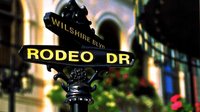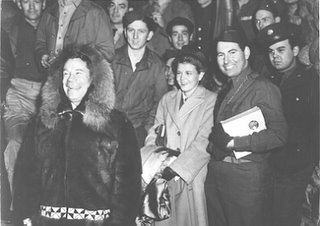Blogging the Wolfe Book, Extra! Extra!
Extra! Extra!
I was raised on the wrong side of the tracks in Beverly Hills.
This is the most marvelously amusing statement. I suppose there are people—somewhere—who might find this believable. But for anybody local, especially a homebuyer, a comment like this is almost indescribably hilarious and I’m starting to wonder if Wolfe was a comedy writer at some point in his career.
In the 1940s, Beverly Hills was a ritzy, exclusive, lily white enclave separate from the city of Los Angeles, with rigidly enforced deed restrictions to keep out non-whites. The only people of color ever seen in Beverly Hills in this era were the maids and chauffeurs. The deed restrictions were so vital to the people of Beverly Hills that several of them filed lawsuits that forced non-whites out of their homes; a very ugly period in Los Angeles history.
The average reader would probably skip by this comment en route to more important things, but then I’m not the average reader and I have a few extra tools at my disposal. So let’s pull the comps on all of Wolfe's riff-raff neighbors on South Camden Drive. (Note to out-of-towners, Camden is one block west of Rodeo Drive).
would probably skip by this comment en route to more important things, but then I’m not the average reader and I have a few extra tools at my disposal. So let’s pull the comps on all of Wolfe's riff-raff neighbors on South Camden Drive. (Note to out-of-towners, Camden is one block west of Rodeo Drive).
On Feb. 18, 1940, the house at 473 S. Camden Drive sold for $13,000 or $172,992.24 USD 2005.
May 25, 1941, a real estate sales report describes a nine-room Spanish home being sold at 309 S. Camden Drive.
June 10, 1941, a report described the sale of a two-story Colonial at 474 S. Camden Drive.
Jan. 31, 1943, the two-story Monterey home at 426 S. Camden sold for $11,500 ($130,353.54 USD 2005).
July 25, 1943, two-story Spanish home at 416 S. Camden sold for $15,000 ($170,026.35 USD 2005)
Aug. 21, 1949, two-story Colonial home, four bedrooms, two baths, den with a half-bath, breakfast room and servants quarters (ahem) at 446 S. Camden Drive. No price listed.
Mind you, even the inflation-adjusted prices are misleading. Anything with four walls and a roof in Beverly Hills goes for megabucks today. For example, the starter house at 344 S. Camden Drive is currently on the market for a little over $2 million.
What’s especially interesti ng in "Mogul" is that Wolfe's neighbors included “strictly name below the title folks” like Joe E. Brown. In 1940, Brown sold his house at 707 N. Walden for $35,000 ($465,748.34 USD 2005), a considerable sum for the era.
ng in "Mogul" is that Wolfe's neighbors included “strictly name below the title folks” like Joe E. Brown. In 1940, Brown sold his house at 707 N. Walden for $35,000 ($465,748.34 USD 2005), a considerable sum for the era.
And if I were writing this story, I wouldn’t be so hard on Brown. A little research shows that he pretty much abandoned his movie and stage career after his son Don was killed on a training flight in 1942 and Brown, shown with servicemen in Alaska, devoted the following years to entertaining the troops in his son’s memory.
Now granted, I don’t read most books at the molecular level as I’m doing here. But most books don’t need to be read at the molecular level either. I warned you this would be tedious. But when Wolfe complains about his pitiful youth on "the lower depths of the south side" it's a bit much. Of all the Dahlia authors, I'd say Steve Hodel, whose mother went to jail for child neglect, has a genuine right to talk about a harsh childhood. But the wrong side of Beverly Hills? Oh really. It is difficult to generate much sympathy for someone who first saw “Gone With the Wind” in the living room of the producer’s home.
But wait…. there’s more
After my parents divorced in 1943, my mother married Jeffrey Bernerd, a movie producer, and we moved north, across the tracks to the land of the majors, where we lived behind one of those mansion doors where “there’s often a great deal of unhappiness.”
The name Jeffrey Bernerd means nothing today, but imdb.com lists him as working on such cinematic triumphs as “Women in Bondage” (1943) and “Black Market Babies” (1945). Bernerd’s Aug. 11, 1950, obituary says that he lived—what’s this?—at 226 S. Camden Drive.
Time to go to the files and dig out the 1946 map of streetcar routes and see exactly where these horrid tracks were (again, not everybody has a 60-year-old streetcar map just sitting around waiting to be consulted, but as I think we’ve conclusively established, not everybody is me and certainly most people don’t read a book this way).
Ah! The map shows a Red Car headed west along Santa Monica Boulevard. Those poor people living in the ghetto south of Wilshire Boulevard—how did they ever make ends meet?
But let’s have a little more fun. We find with a little digging that Wolfe’s mother, Elizabeth, married Bernerd on April 2, 1945, at Bernerd’s home. We also learn that Wolfe’s father was Sailing Wolf e, a real estate salesman who was a nephew of Bernard Baruch. (Sailing Wolfe was apparently named for Baruch’s grandfather).
e, a real estate salesman who was a nephew of Bernard Baruch. (Sailing Wolfe was apparently named for Baruch’s grandfather).
I’m blogging this as I read, so I have no idea what’s coming up. But I just flipped to the index to see if maybe we’re going to learn something about Sailing Wolfe or Bernard Baruch, left, in one of his three appearnces on the cover of Time magazine.
Not a word.
Hm. This is starting to look bad. I think if I were the grand-nephew of one of the world’s leading financiers I might just drop it in somewhere. Not make a big deal out of it but maybe I’d allude to it.
And about that impoverished childhood? We find that in 1941, Mrs. Sailing Wolfe was a member of Beverly Hills Assistance League (helping the less fortunate, presumably) and seemed to have had enough disposable income to collect Currier and Ives prints.
I have to go for a walk.
Labels: Black Dahlia, Books and authors, LAPD, Obituaries, Real Estate, Streetcars







